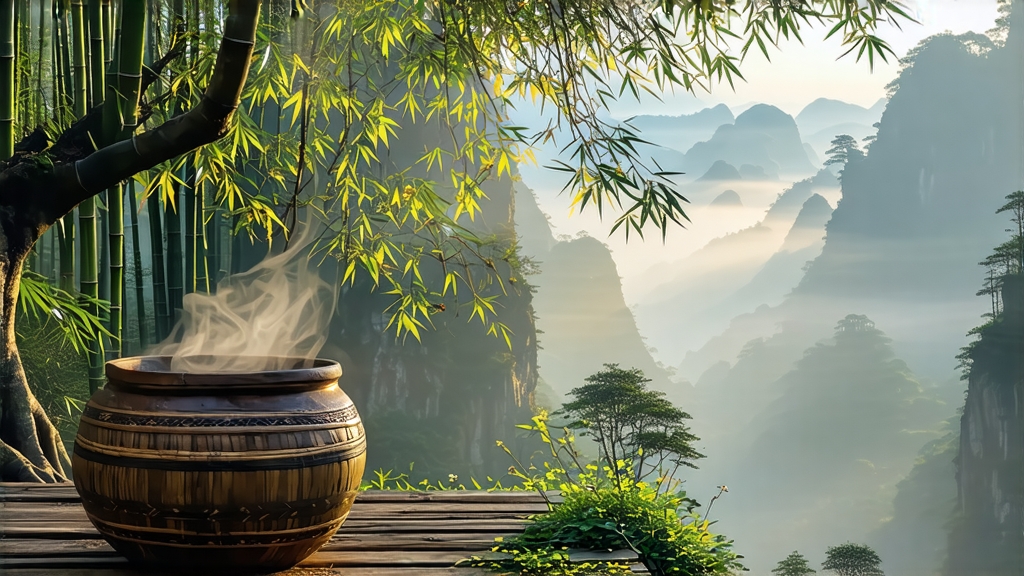
Tucked away in the cloud-veiled peaks of Sichuan’s Meng Ding mountain range, Meng Ding Huang Ya—literally “Meng Ding Yellow Bud”—is the quiet aristocrat of China’s six major tea families. While green teas grab headlines and pu-erhs fill auction catalogs, this yellow tea has spent thirteen centuries polishing its manners in near anonymity. First entered into the Tang dynasty tribute register in 724 CE, it was plucked exclusively for emperors until the fall of the Qing; when the imperial courier road vanished, so did the tea from public memory. Only a handful of family workshops on the 1,450 m slopes still know the exact choreography that turns a spring bud the color of liquid topaz, and they speak of it in the hushed tones reserved for ancestral secrets.
Meng Ding Huang Ya is not a brand but a micro-appellation: true leaf must come from three named peaks—Shangqing, Lingyao, and Ganlu—within a 12 km radius. Here, Sichuan basin humidity collides with alpine coolness, creating a 280-day fog season that slows photosynthesis and packs the buds with theanine and soluble sugars. Two cultivars dominate: the local “old bush” Camellia sinensis var. sinensis ‘Ganlu 1’, whose leaves are peach-fuzz tender, and the more recent ‘Sichuan Yellow 131’, bred to withstand the repeated heat shocks of yellowing without collapsing. Gardens are terraced among camphor and ginkgo, whose roots share mycorrhizal networks that soften the tea’s tannins and add a faint camphor lift to the cup.
Harvest is a race against the Qingming festival. Pickers climb bamboo ladders before dawn, selecting only the “sparrow’s tongue”—a bud and half-open first leaf no longer than 2.5 cm. Each kilo of finished tea needs 42,000 such tips, all carried downhill in wicker back-baskets lined with fresh banana leaves to prevent bruising. By 9 a.m. the mountain gate closes; no leaf picked after the sun burns off the mist may call itself Meng Ding Huang Ya.
The magic lies in the “sealed yellowing,” a process that sits between green tea killing-green and white tea withering. First, the leaves are pan-fired at 160 °C for four minutes in iron woks brushed with tung oil, deactivating roughly 70 % of polyphenol oxidase while preserving a core 30 % that will drive slow oxidation later. No machines: the master’s bare hand is the thermometer, inserted into the leaf pile until the heat becomes unbearable—exactly three Mississippi. Next comes men huang, “sealed yellowing,” unique to yellow teas. The still-warm leaves are wrapped in thick canvas bundles the size of rugby balls and placed in a 35 °C, 75 % RH fermentation chamber built from volcanic stone. Every forty minutes the bundles are opened, fluffed, and re-wrapped; over 72 hours the leaf edges turn ochre, the midrib lemon, and the aroma migrates from cut grass to dried apricot. The cycle is repeated three times with gradually lower temperatures, a ritual known as san g huang, “three breaths of yellow,” lengthening the tea’s finish from seconds to minutes.
Once the master judges that chlorophyll has retreated just enough to reveal a jade undercoat, the leaf is given a final charcoal bake. Meng Ding workshops use local mao bamboo, split, dried, and burned down to embers in a sunken pit. A bamboo sieve holding the tea is suspended 60 cm above the coals; the sieve is rotated every thirty seconds so that the leaf receives only radiant heat, never smoke. The temperature curve is a sine wave: 55 °C for ten minutes, rest five, 50 °C for fifteen, rest five, 45 °C to completion. This lulls the residual enzymes to sleep while caramelizing surface sugars, sealing in the tea’s signature “chestnut-milk” note.
Finished Meng Ding Huang Ya is a slim, slightly curved strip the color of antique gold. Under a 10× loupe you can see a downy trichome network intact, proof that the leaf was never crushed. The dry fragrance is subdued: think dry mango skin and faint pine honey. Once brewed, the leaf rehydrates into a single intact bud-and-leaf set, a silent ballet that Chinese judges call “the phoenix rising.”
Water is the tea’s stage. Use a porcelain gaiwan of 120 ml, 4 g of leaf, and spring water